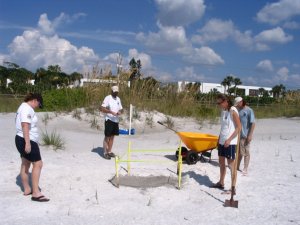Grant: 08-021R
Project Title: Implications of Temperature-Dependant Sex Determination for the Conservation & Biology of Loggerhead Sea Turtles in Florida
Project Manager: Thane Whibbels
Organization: University of Alabama at Birmingham (Research and Educational Institute)
Grant Amount: $6,961.00
Completion Date: 2012-11-07
Summary: Sea turtles possess temperature-dependent sex determination (TSD) which has significant implications for their conservation and biology. Through previous funding from the Florida Sea Turtle Grants Program we have developed an extensive collaborative network for the simultaneous evaluation of beach temperatures (using data loggers buried at nest depth) on twenty-one loggerhead nesting beaches throughout Florida. This database facilitates the development and testing of basic hypotheses regarding implications of TSD to the conservation and biology of loggerhead sea turtles in Florida. This project will allow us to test two specific hypotheses. The results will provide fundamental information that can be directly incorporated into the management strategy for loggerhead sea turtles in Florida. The first hypothesis is that the Florida Panhandle Management Unit (FPMU) of loggerheads sea turtles may be of ecological significance to the population of loggerheads in southeastern U.S. due to nesting beach temperatures. The second hypothesis to be tested is that beach renourishment can significantly alter nesting beach temperatures and thus affect hatchling sex ratios. Results: This research sponsored by the Sea Turtle Grants Program provided the foundation for a multi-year project investigating beach temperatures that were simultaneously recorded at nest depth on a wide range of nesting beaches used by loggerhead sea turtles in Florida and in the Southeastern U.S. The results were combined with previous data to provide six continuous years of temperature data collection (2004-2009). The results indicate that temperatures vary significantly between loggerhead nesting beaches. The results also indicate that the spectrum of beaches used by the loggerhead population in the southeastern U.S. include a wide variety of thermal profiles, with potential sex ratios ranging from high female biases to male biases depending on the specific beach. In general, nesting beaches temperatures along the Atlantic coast of Florida (e.g. Melbourne Beach, Juno Beach, Hutchinson Island), where the majority of nesting occurs, were relatively warm suggesting the production of female-biased sex ratios. The histology-based hatchling sex ratio data support the hypothesis that female biases may often be produced on nesting beaches on the Atlantic coast of Florida. In contrast, a few locations (e.g. Cape San Blas on the Florida panhandle) were consistently cooler suggesting the production of a greater proportion of males. However, these locations represented minor nesting beaches compared to those on the Atlantic coast. These finding are consistent with the hypothesis that sex ratio production is beach-specific, but the loggerhead population in the southeastern U.S. is producing an overall female-biased sex ratio. The results provide a basis for suggesting which beaches in the southeastern U.S. are important for the production of female and male loggerheads. The results also indicate that factors associated with beach nourishment projects such as sand type, can significantly influence beach temperature, and thus hatchlings sex ratios. Finally, the results represent a foundation for a temperature database for evaluating potential long-term changes in beach temperatures associated with global climate change. The data indicate that many of the most important nesting beaches for loggerheads are already relatively warm and may be producing strong female biases, thus having little leeway for potential temperatures increases in future years.
Results: This research sponsored by the Sea Turtle Grants Program provided the foundation for a multi-year project investigating beach temperatures that were simultaneously recorded at nest depth on a wide range of nesting beaches used by loggerhead sea turtles in Florida and in the Southeastern U.S. The results were combined with previous data to provide six continuous years of temperature data collection (2004-2009). The results indicate that temperatures vary significantly between loggerhead nesting beaches. The results also indicate that the spectrum of beaches used by the loggerhead population in the southeastern U.S. include a wide variety of thermal profiles, with potential sex ratios ranging from high female biases to male biases depending on the specific beach. In general, nesting beaches temperatures along the Atlantic coast of Florida (e.g. Melbourne Beach, Juno Beach, Hutchinson Island), where the majority of nesting occurs, were relatively warm suggesting the production of female-biased sex ratios. The histology-based hatchling sex ratio data support the hypothesis that female biases may often be produced on nesting beaches on the Atlantic coast of Florida. In contrast, a few locations (e.g. Cape San Blas on the Florida panhandle) were consistently cooler suggesting the production of a greater proportion of males. However, these locations represented minor nesting beaches compared to those on the Atlantic coast. These finding are consistent with the hypothesis that sex ratio production is beach-specific, but the loggerhead population in the southeastern U.S. is producing an overall female-biased sex ratio. The results provide a basis for suggesting which beaches in the southeastern U.S. are important for the production of female and male loggerheads. The results also indicate that factors associated with beach nourishment projects such as sand type, can significantly influence beach temperature, and thus hatchlings sex ratios. Finally, the results represent a foundation for a temperature database for evaluating potential long-term changes in beach temperatures associated with global climate change. The data indicate that many of the most important nesting beaches for loggerheads are already relatively warm and may be producing strong female biases, thus having little leeway for potential temperatures increases in future years.